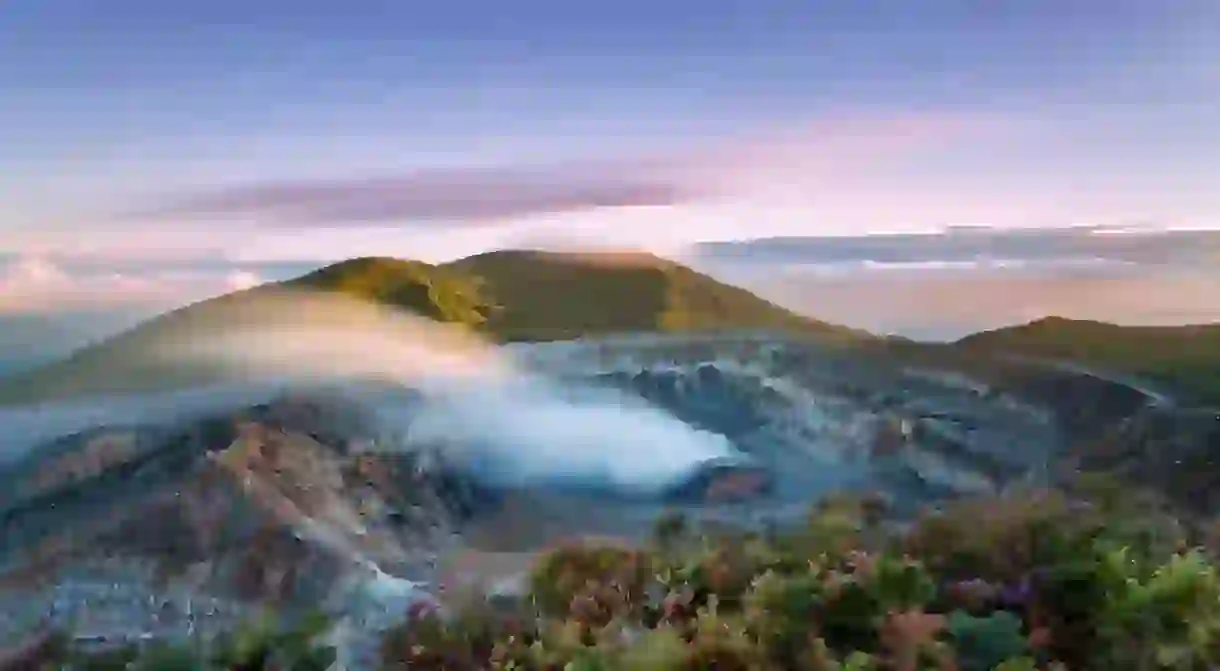The Best Volcanoes to See in Costa Rica

The spine of Costa Rica dates back more than 65m years and rests along the Pacific Ring of Fire. This dramatic landscape contains at least 200 volcanic formations yet, of these, just a handful are classified as active volcanoes.
Given these forces of nature can lay dormant for millennia, a volcano is not actually considered active unless it has erupted in the past 11,000 years. Local agitations, such as unusual earthquake activity and emissions of gas, are telltale signs that something stirs beneath the precipice. So, which is the best active volcano to see in Costa Rica for an awe-inspiring – but safe – experience?
Arenal Volcano
Since 2010, Arenal hasn’t stirred. Before then, it was the most active volcano in Costa Rica. Renowned for both its conical shoulders that rise 5,480ft (1,670m) above the canopy and for provoking the 10th-longest eruption in recent history, this volcano is a potent force of the tropical landscape. The lush rainforest of Arenal Volcano National Park is home to the waterfall of La Fortuna as well as multiple hot springs. At only 7,500 years old, this peak is the youngest volcano on this list.
Irazú Volcano

Although the highest active volcano in Costa Rica, at 11,260ft (3,432m), Irazú is one of the easiest to visit, sitting within proximity of the capital, San José. It even has a road leading right up to the summit traversed by a weekly bus service. Between 1963 and 1965, a major eruption showered the nearby capital with ash and besieged the countryside with floods, landslides and mudflows. This historic penchant for catastrophe has earned Irazú the nickname El Coloso (the Colossus). On a rare cloud-free day (there’s only three or four per year), you’ll be able to see both the Pacific and the Caribbean Sea from its peak. Irazú is at least 850,000 years old.
Tenorio Volcano

Comprising four volcanic peaks and two craters, the summit of Volcán Tenorio is sadly off-limits to the public without special permission. The wider Tenorio Volcano National Park, however, makes this destination more than worthwhile. You’ll tread through the savannah, rainforest and elfin cloud forest before you happen upon the surreal blue of the Rio Celeste. The volcanic earth produces thermal springs and small geysers; look out for tapirs and even pumas in the undergrowth. Since 2019, the park has imposed limits on visitor numbers to avoid overcrowding, so you can be sure your visit here will be a relaxing one.
Barva Volcano

Barva is the quietest volcano on this list, with the last confirmed eruption dating back over 8,000 years. But don’t take this as a reason not to visit. Close to San José, Barva is rooted in the luscious greenery of Braulio Carrillo National Park, making it an ideal day trip. You can hike the many trails that traipse through this region, carrying you to parasitic cones sown into mountain flanks and to multiple lagoons – including the emerald Laguna de Barva, which dwells in what was the volcanic crater. When viewed from the Central Valley, Barva has three principal summits, earning it the local nickname of Las Tres Marías (the Three Marys).
Rincón de la Vieja Volcano

This volcano, with a name that translates to Old Woman’s Corner, has nine volcanic craters. Its name is a reference to a local legend: the lover of Princess Curabanda, who was from an enemy tribe, was thrown into a crater by her angered father. In grief, she became a recluse on the mountainside, credited with healing powers in older age. Gaining access to the tempestuous crater hasn’t been possible since 2011, but the surrounding forest, hot springs and gushing falls of Rincón de la Vieja National Park make this a worthwhile trip.
Poás Volcano

The most explosive volcano on this list, Poás has erupted 40 times in the past 200 years. In 2017, an eruption led to an evacuation and closure of the Poás Volcano National Park; it was reopened to visitors with limited access to the crater in 2018. You’ll find two crater lakes near the summit. Laguna Caliente is one of the most acidic lakes in the world and supports no aquatic life, and Lake Botos is filled with cold, green water and sits in an inactive crater that last erupted in 7500BCE. The park also contains coffee plantations, so be sure to combine your sightseeing with a local brew.
Turrialba Volcano

Another erratic stack, the towering Turrialba measures 10,960ft (3,341m) and has had at least five meteoric eruptions in the past 3,500 years, with minor ones right into 2021. Its home, the Turrialba Volcano National Park, reopened to the public in December 2020 after an eight-year closure. Unlike the days in which hikers were able to journey down inside the main crater, a 1m (2km) safety perimeter is now in place. Like its neighbor Irazú, you can see the Pacific and Caribbean coasts on the all-too-rare clear days at this dizzying altitude.













